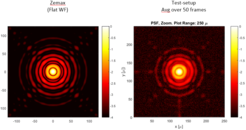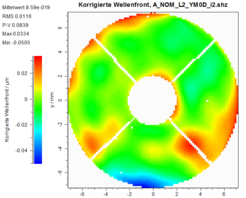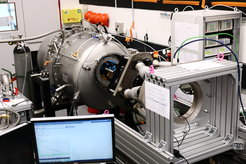Euclid NI-OA opens its eyes!

The picture shows the simulated (left) and recorded (right) high resolution image of the NISP NI-OA system at near infra-red light with a wavelength of 920nm. Contrast and symmetry of the spot are well within specification.
Euclid will study the “Dark Universe” with great precision, tracing the distribution and evolution of the enigmatic dark matter and dark energy throughout the Universe. The satellite will use a 1.2-m diameter telescope with two instruments to map the three-dimensional distribution of some two billion galaxies and of the dark matter that surrounds them, over one third of the whole sky. Stretched across ten billion light years of the Universe, the results of the mission will plot the evolution of structure over three-quarters of its history.

These wave-front measurements of the system show that the deviation from a perfect optical system is almost negligible. It is expected that the optics will perform perfect within the physical limit of diffraction.
The Max Planck Institute for Extraterrestrial Physics (MPE) is responsible for the complex optics for the near-infrared instrument NISP aboard Euclid. The optics consists of four lenses of about 17cm in diameter and has been developed in recent years by a team at MPE. It is implemented in cooperation with OHB Munich and the Carl-Zeiss Jena GmbH.

Tests were performed in a complex set-up where the optics are placed in a large cryo-vacuum vessel (left hand side) to simulate space conditions. The actual telescope is replaced by a moving test optics held and agitated to micrometre accuracy by a hexa-pod robot (right hand side).
The Euclid team at MPE now proudly announces that NISP has for the first time produced real images under cryogenic and vacuum conditions. The picture obtained in a complex set-up show that the optical characteristics are well within specification and that the deviation from a perfect optical system is almost negligible. To simulate conditions in space, the optics was placed in a large cryo-vacuum vessel. The actual telescope is preplaced by a moving test optics held and agitated to micrometer accuracy by a hexapod robot, whose six legs give it simultaneously good stability and a lot of flexibility. With these final tests and verifications the optical assembly flight model is now fully qualified for instrument integration and will be delivered to the instrument by the end of May.














